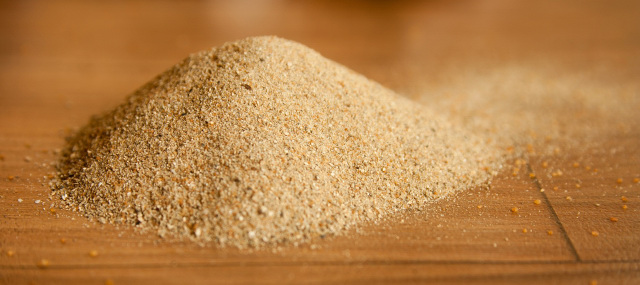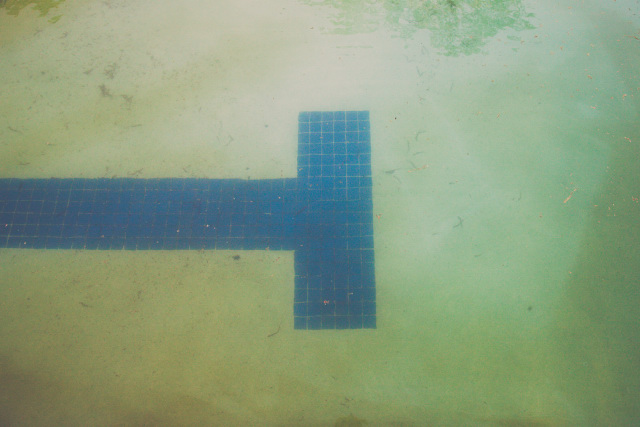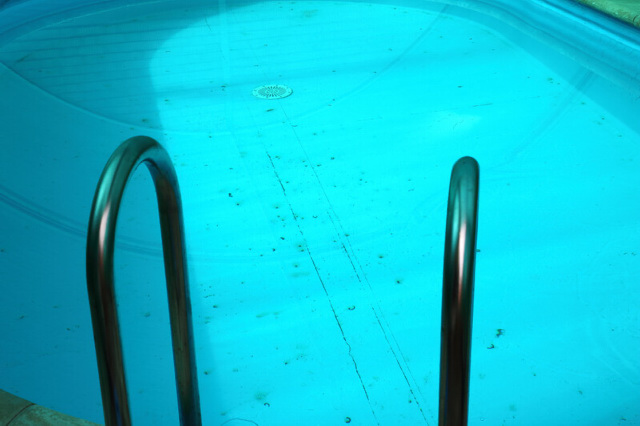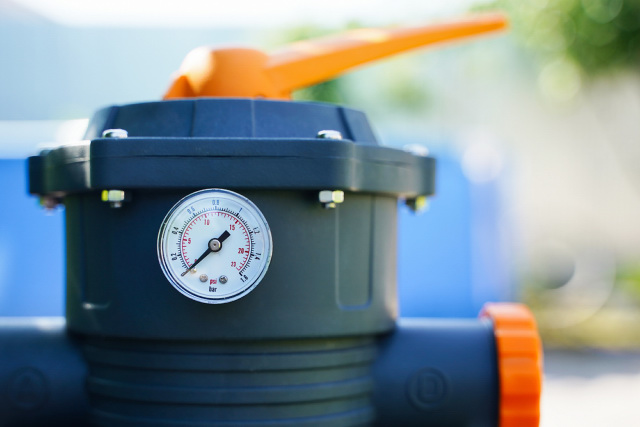Your sand filter has been running well up until now. But the time has come to replace the sand, and you have no idea how much sand to add. How far should you fill up your sand filter? Does it require 2 bags of sand or 5?
If your sand filter is 16 inches (41 cm) in diameter, then you need 100 pounds (2 x 50 lbs bags) of sand for the filter. Once your filter surpasses 16 inches (41 cm) in diameter until 20 inches (51 cm), increase the sand by 25 pounds (1/2 a bag) for every extra inch in diameter.
In today’s guide to sand filter refilling, we’ll discuss more specifically how much sand you need and also cover what happens if you overdo it or underdo it on the sand. You won’t want to miss it!

Article Contents
What to Do If You Add Too Much Sand to a Filter?
Perhaps you found this article only after you overfilled your sand filter with sand. At the time, you hadn’t realized there was an upper limit for sand, but now your swimming pool filter isn’t working quite right.
What kinds of issues should you expect from an overloaded sand filter? Let’s go over them now.
High Filter Pressure
Your sand filter is only supposed to operate at a certain pressure. If you keep the right amount of sand in the filter, then the pressure won’t exceed that limit.
However, overdoing it on the sand in the filter is going to increase the pressure. In turn, the sand filter is not going to work correctly.
That means your pool can quickly become murky, cloudy, green, and dirty.

You can go through all the other components of your pool for days trying to figure out what’s causing your pool to become so filthy. Then it hits you that something is wrong with the filter.
Possible Filter Breakage
Pool filters aren’t meant to operate at high pressures for prolonged periods.
Maybe your sand filter will survive the first bout of too much sand, but if you make overfilling the filter a habit, then it’s only a matter of time before the filter succumbs to the high pressure.
Sand filters can cost anywhere from $350 to $500 and up, so you don’t exactly want to replace yours any more often than you have to!
Sand in the Pool
Another unfortunate consequence of too much sand in the filter is that the sand could escape.
Maybe some of it begins leeching out into your pool in everyday circumstances, or perhaps it takes rinsing or backwashing the pool for the sand to seep out.
Either way, you may end up with sand sitting on the bottom of your pool. Which doesn’t feel nice under your feet. Then you’ll have to spend hours cleaning the pool, and even then, getting rid of every last little grain of sand can be difficult!
Related Reading: What is a Normal Pool Filter Pressure Range?
How Much Sand to Put in a Sand Filter (lbs)
Okay, so exactly what is the weight of sand you’ll need for a sand filter? Here’s a helpful chart that breaks down the weight of sand needed to fill up your sand filter.
| Sand Filter Diameter | How Much Sand to Add (In Pounds) |
| 16 inches (41 cm) | 100 pounds |
| 18 inches (46 cm) | 150 pounds |
| 19 inches (48 cm) | 175 pounds |
| 20 inches (51 cm) | 200 pounds |
| 22 inches (56 cm) | 250 pounds |
| 24 inches (61 cm) | 300 pounds |
| 27 inches (69 cm) | 350 pounds |
| 30 inches (76 cm) | 500 pounds |
| 36 inches (91 cm) | 700 pounds |
How Many Bags of Sand to Put in a Sand Filter
Pool filter sand (silica sand), is usually sold in 50 lb bags. So we’ve made it easy for you. This table will tell you exactly how many 50 lb bags of sand you’ll need when refilling your sand filter.
| Sand Filter Diameter | How Many Bags of Sand to Add |
| 16 inches (41 cm) | 2 pounds |
| 18 inches (46 cm) | 3 pounds |
| 19 inches (48 cm) | 3.5 pounds |
| 20 inches (51 cm) | 4 pounds |
| 22 inches (56 cm) | 5 pounds |
| 24 inches (61 cm) | 6 pounds |
| 27 inches (69 cm) | 7 pounds |
| 30 inches (76 cm) | 10 pounds |
| 36 inches (91 cm) | 14 pounds |
Now that you’ve seen the charts, let’s talk more about the information therein.
As we mentioned in the intro, the standard size diameter for sand filters is 16 inches (41 cm). You’ll need 100 pounds (2 bags) of sand for a filter of that size, which might be more than you were thinking (or perhaps it’s even less!).
Do you have a pool filter that’s larger in diameter than 16 inches (41 cm) but doesn’t exceed 20 inches (51 cm)? For each inch in diameter of your pool filter, pour in 25 pounds (1/2 a 50 lb bag) more sand.
For example, a sand filter with an 18-inch (46 cm) diameter needs 150 pounds of sand while a filter with a 19-inch diameter (48 cm) needs 175 pounds of sand.
Once your sand filter surpasses 20 inches (51 cm) in diameter but doesn’t exceed 24 inches (61 cm) in diameter, then for every two inches of diameter, you’d pour in 50 additional pounds of sand.
A 20-inch (51 cm) sand filter needs 200 pounds of sand and a 22-inch (56 cm) sand filter requires 250 pounds of sand, as examples.
Once your sand filter is 24 inches (61 cm) in diameter but doesn’t exceed 27 inches (69 cm) in diameter, then you increase the amount of sand to 50 pounds per three inches in diameter.
A 24-inch (61 cm) sand filter needs 300 pounds of sand, for instance.
For sand filters bigger than 27 inches (69 cm) in diameter, once you go three inches above that, you need 150 to 220 pounds of sand.
Related Reading: When to Change the Sand in the Pool Filter (And the Risks)
Common Sand Filter Brands & How Much Sand You Need
Do you have a sand filter by a common manufacturer and you’re wondering how much sand to put in your filter? This section will tell you everything you need to know!
| Sand Filter Brand | Size of Sand Filter | How Much Sand (In Pounds) |
| Hayward | 16 to 23 inches (41 to 58 cm) | 100 to 250 pounds |
| Raypak | 14 to 28 inches (36 to 71 cm) | 80 to 150 pounds |
| Pentair | 19 to 22.5 inches (48 to 57 cm) | 150 to 250 pounds |
| Intex | 14+ inches (36+ cm) | 77+ pounds |
| RX Clear | 22 to 24 inches (56 to 61 cm) | 220 to 300 pounds |
This table shows how many bags of sand are needed for common brands of sand filters.
| Sand Filter Brand | Size of Sand Filter | No. of 50 lb Bags of Sand |
| Hayward | 16 to 23 inches 41 to 58 cm) | 2 to 5 bags |
| Raypak | 14 to 28 inches (36 to 71 cm) | 2 to 3 bags |
| Pentair | 19 to 22.5 inches (48 to 57 cm) | 3 to 5 bags |
| Intex | 14+ inches (36+ cm) | 1.5 bags |
| RX Clear | 22 to 24 inches (56 to 61 cm) | 4.5 to 6 bags |
As the information in the charts above shows, sometimes the amount of sand that a sand filter requires is less than what the chart from the last section would suggest.
If you’re torn between the two charts and wondering how much sand to add, here’s what we recommend. Always defer to the manufacturer’s instructions.
We’ll talk in the next section about what happens if you add too little sand to a filter, and while it’s not great, it’s always better to have too little sand than too much.
You can easily add more sand to balance out your filter but taking out the sand is a little harder.
What Happens If You Add Too Little Sand to a Filter?
Earlier, we discussed the risks of adding too much sand to a sand filter. If you need a recap, the filter’s pressure can raise, eventually causing filter breakage. The sand can also seep out of the filter and into your swimming pool.
In this section, we want to discuss the opposite issue. All this time, your filter has been operating on too little sand.
What’s the harm in that? We’re glad you asked! Here’s what can happen if your swimming pool continues to operate with too little sand in the filter.
Inefficient Filter Performance
A sand filter only works as well as how much sand it has. If your filter lacks sand, then, of course, it’s not going to be able to filter particles from your swimming pool all that efficiently. The sand is what captures the debris and if there isn’t enough, then the debris won’t be trapped.
Dirty Pool
After a few days of your sand filter working in less-than-optimal conditions, your pool is going to become cloudy, murky, and filthy.

Risk of Excess Chlorination
It’s been several days and your pool hasn’t cleared up. You may begin shocking the pool and chlorinating it to excess, which can throw the balance of your pool all out of whack.
The pool won’t be much cleaner though since your sand filter is still not filtering the water. Until you figure out what the true culprit is, then you can tear your hair out trying to keep your pool in good condition in a situation like this!
Related Reading: How to Deep Clean a Sand Filter (And Change Sand)
Sand Filter Problems to Be Aware Of
Even if you’re using the optimal amount of sand in your sand filter, the filter is still susceptible to the following issues.
Tank Cracking
Every few months, it’s a good idea to inspect the exterior of your sand filter, looking for cracks anywhere along the tank.
Even if the cracks are as thin as a spiderweb, they won’t stay that way forever.
A common cause of cracked sand filters is freeze damage. That is, if the filter isn’t properly drained and winterized, and you live where temperatures go below zero, the water in the tank will expand and damage your filter.
Unfortunately, once a sand filter tank cracks, there’s no fixing it. You can’t glue the crack or put duct tape on it. Instead, you need to replace the tank altogether.
Pressure Changes

High sand filter pressure isn’t only caused by too much sand in the filter. The sand can become dirty and that too will raise the filter’s pressure.
By backwashing your sand filter, you can reduce the pressure. Unblocking any potential obstructions should also bring the pressure down.
What if the sand filter’s pressure is already too low? This can mean you have a blockage at the skimmer or a leak on the suction side of the pump. The suction side is the side of the pump that sucks the water in from the pool. The water then goes through the pump, through the filter, and is returned to the pool.
The sand filter’s pressure is considered low if it’s under 10 pounds per square inch of pressure or PSI.
Waste Line Leak
The waste line should drip if you backwash the pool, but not otherwise. More than likely, something is wrong with the spider gasket if your waste line is leaking.
While you could replace the spider gasket yourself, it’s a bit of a complicated job. You should contact your pool technician instead to ask them about changing out the spider gasket.
Multiport Valve Handle Damage
Sand filters use a multiport valve for sending pool water in for filtering. The multiport valve also allows you to rinse, recirculate, and backwash pool water.
If the handle gets stuck or loose or damaged, then the multiport valve might not work properly.
A stuck or broken handle should come off, which you can do by removing the valve lid of the key cover assembly and tapping on the lid with a hammer. If you’d rather your pool technician replace the multiport valve, that’s an option as well.
Related Reading: What To Do with Old Pool Filter Sand (Answered!)

